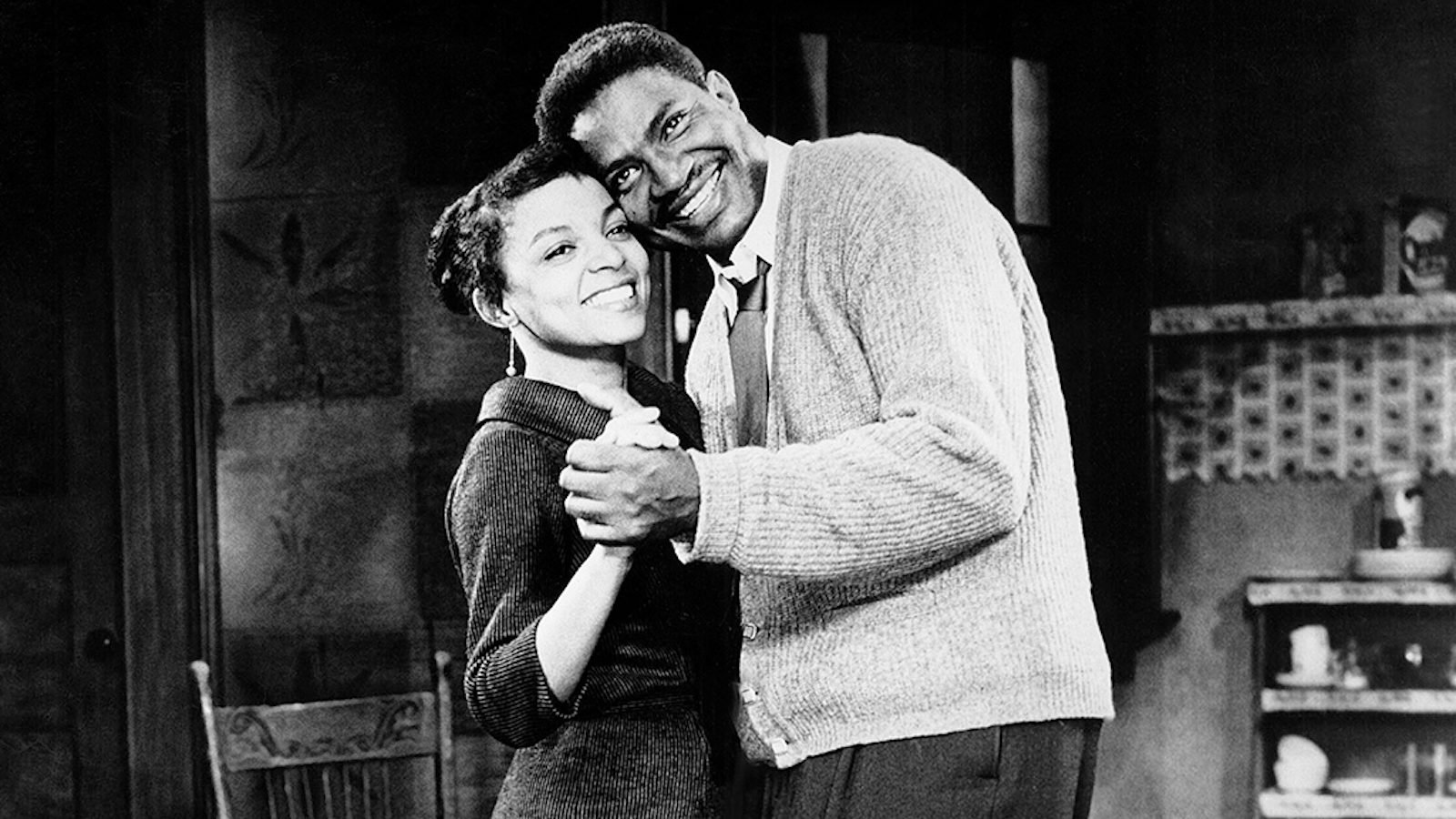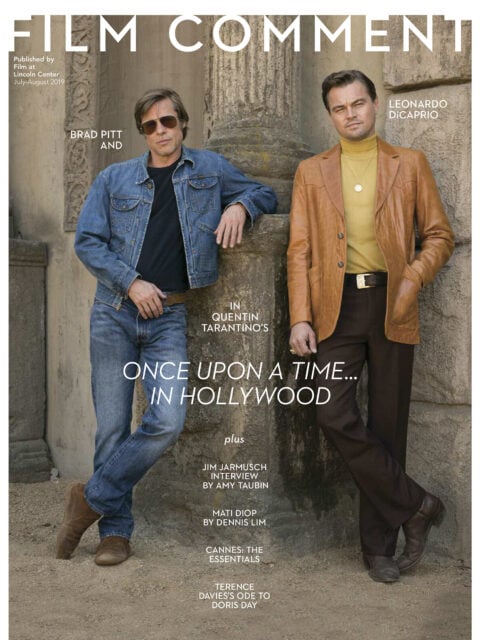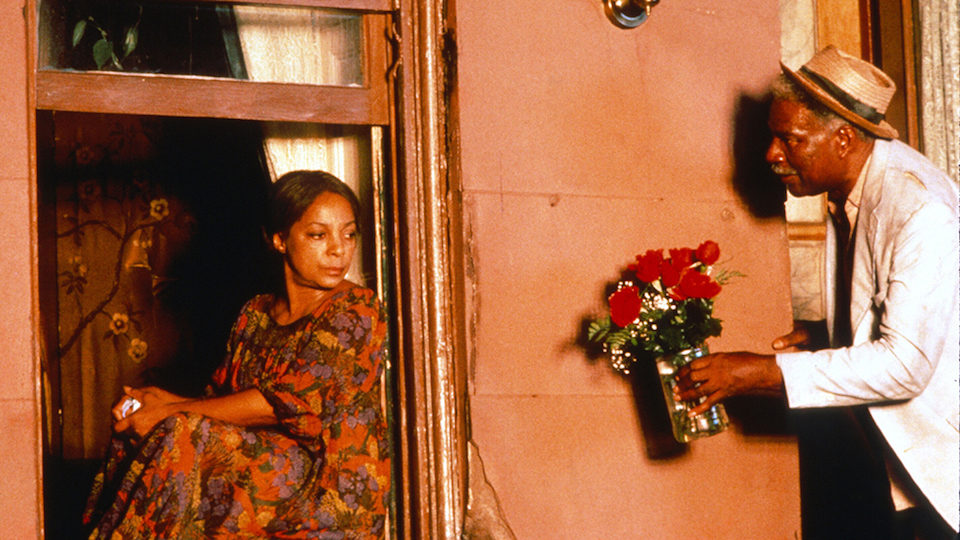By Shonni Enelow in the July-August 2019 Issue

Feel the Love
Thirty years after Do the Right Thing, the revolutionary acting legacy of Ossie Davis and Ruby Dee still yields lessons to learn beyond realism
At the end of Spike Lee’s Do the Right Thing, after the murder of Radio Raheem (Bill Nunn) by the police and the fire that destroys Sal’s Pizzeria, we see morning return to the neighborhood through the eyes of its elders, Da Mayor and Mother Sister, whose roles in the film depend on audiences’ intimate familiarity with the actors playing them: Ossie Davis and Ruby Dee. The conclusion finds them in Mother Sister’s bedroom where Da Mayor wakes up: “Hope the neighborhood is still standing,” he says; “we’re still standing,” she replies. They move toward the window, which frames them as they peer out, surveying the wounded block, as the camera spins to Mookie (Spike Lee) below.

From the July-August 2019 Issue
Also in this issue
So powerful is the symbolic presence of Dee and Davis in Do the Right Thing that their performances almost demand to be read allegorically. And they have been, since the film’s 1989 release: reviewing in The New York Times, Vincent Canby wrote that Dee and Davis “preside over it, as if ushering in a new era of black filmmaking.” When their shared archive was acquired by the Schomburg Center for Research in Black Culture last year, Jennifer Schuessler implicitly cast the film as the culmination of their lives’ work as the first couple of African- American acting, tracing their paths from Harlem theater in the 1940s, through many years of lauded performances and political activism, to the crowning cinematic moment of Do the Right Thing.
Lee’s film directly invites this reading, but the focus on this one particular allegory—the generational allegory—has obscured something important about the way these performances function in the film. Dee and Davis are not there simply to stand in for their generation; they are, more specifically, representatives of a performance culture that was directly connected to the politics of a historical moment. Ossie Davis and Ruby Dee, actors, writers, organizers, and activists widely referred to as the “first couple of the Civil Rights Movement,” and credited by Oprah Winfrey as forerunners to her own “crossover” success as an African-American public figure, were everywhere in the 1960s. Already famous for their theater work, particularly their performances in Lorraine Hansberry’s A Raisin in the Sun in 1959 (Dee originated the role of Ruth; Davis took over the role of Walter Lee from Sidney Poitier), and for their support of blacklistee Paul Robeson (for which they were subpoenaed by the House Un-American Activities Committee), they boast a dual biography that reads like a timeline of progressive politics: in 1963, they were emcees at the March on Washington for Jobs and Freedom and formed the Association of Artists for Freedom with James Baldwin, Odetta, and others; in 1965, Davis gave the eulogy for Malcolm X; in 1966, they both participated in the Read-In for Peace in Vietnam; in 1967, Davis spoke at the famous meeting of the Clergy and Laity Concerned about Vietnam, where Martin Luther King Jr. came out against the war; in 1968, Davis spoke at his memorial. In between, they campaigned, wrote letters, made speeches, published articles and responses—and performed, wrote, and produced theater and film. As a couple who frequently worked together, they are among the rare successful married artists who have become iconic as paragons of marriage itself; as performers equal in stature and lauded as both artists and public figures, they remain unmatched in American culture.
Today, in 2019, 30 years after Do the Right Thing’s release, as more and more mid-century icons recede through natural or unnatural attrition (people die; histories get rewritten), it’s a good time to reassess the film vis-à-vis Dee and Davis, and think more deeply about what it means that Lee presents these two as ancestors and antecedents. It also feels important, as mid-century performance styles themselves recede, to reassess how the film’s questioning of the politics of representation extends to acting. If the question at the heart of Do the Right Thing is how to conceive post–“Martin and Malcolm” black political action, what does the film present as post–“Ruby and Ossie” black political acting?
It’s rarely observed that so many of Lee’s movies are explicitly about acting, despite the attention given to the filmmaker’s broader critique of cinematic representation. But just think about the emphasis on acting—crucially, vocal acting, a distinction I’ll return to—in 2018’s BlacKkKlansman, a film whose narrative follows the creation of a character for performance. Or think about Bamboozled, another film that is not just about representative images but about embodiment. Looking at Do the Right Thing through this lens, we can start to rethink its own critique of representation, which, again, is not only about images of identification—though the conflict at the center of the narrative begins when Buggin’ Out (Giancarlo Esposito) objects to the exclusion of black celebrities from Sal’s “Wall of Fame”—but also about portrayals of character.
Do the Right Thing is an anthology of performance styles: from the music-video dance number of Tina (Rosie Perez), framed by theatrical lighting, that opens the credits, to the Greek chorus of ML (Paul Benjamin), Coconut Sid (Frankie Faison), and Sweet Dick Willie (Robin Harris), the film presents a collage of theatrical genres, each character or group of characters with their distinct theatrical mode. Running through the episodes that open the film, we move from the smooth radio-voice tones of Mister Señor Love Daddy (Samuel L. Jackson), the deejay; to the evangelical street hawking of Smiley (Roger Guenveur Smith); to the mid-century realism of Sal (Danny Aiello) and his sons Pino (John Turturro) and Vito (Richard Edson), with their Arthur Miller–esque drama of white, ethnic, lower-middle-class disillusionment; to the old-fashioned, vaudeville-like conflict of Da Mayor and Mother Sister, who play out their sparring to a scoring of antebellum strings.
These last two genres are worth thinking about together, because if the film proposes that the acting style of Dee and Davis is the ancestor of Lee, Esposito, and Nunn’s, then that of Aiello and Turturro is its antithesis. Theirs is the still-dominant aesthetic of American performance: psychological realism, colloquially known as “method acting,” which is not just a technique for creating a character, but also a narrative form. When Aiello suggested to Lee that he include an extra scene between Sal and Pino and improvised its dialogue with Turturro—as the highly publicized story goes—it was a scene that carefully delineated these characters’ feelings, psychology, and backstory: how long Sal has owned the restaurant, how his son feels about it, why he holds onto it, with each element of context demonstrating Sal’s psychological motivations. Aiello was nominated for the Academy Award for Best Supporting Actor that year, not insignificantly because of the character depth communicated by this scene, and its role in drawing sympathy for his character from the Academy’s presumed audience, a white audience. The story of Aiello’s creative role reveals not just his importance as an actor in shaping the film, but also the ways in which actors in general rely on particular understandings of the content of dramatic character, and how those ideas affect the meanings of the performances they produce.
And this particular understanding of character is entirely related to race. Aiello is part of a lineage of American acting that not only developed concurrently with but also played a role in the assimilation of European ethnic groups—Jews and Italians, most centrally—into whiteness. The black actors who succeeded within this system (as James Baldwin, at one point close with Elia Kazan, discovered) did so by conforming to a set of performance standards that many black artists came to reject. In fact, what seems to have been missed by the audience from whom this performance style garnered so much praise is the way in which Lee subtly critiques it throughout the film. When Radio Raheem derisively asks of Sal, “Who the fuck he think he is, Don Corleone and shit?” naming the character’s behavior as an inauthentic and unsuccessful performance, his reference encompasses both the ethnic content of Coppola’s film and the acting style associated with it. And the priority of psychological backstory—another key feature of psychological realism—is called into question when Da Mayor is insulted by Ahmad (Steve White), one of four teenagers bouncing around the neighborhood. “What you know about me?” Da Mayor sputters. “Unless you done stood in the door and listened to your five hungry children crying for bread . . . unless you done done that, you don’t know me, my pain, my hurt, my feelings…” “I hope you finished your little soliloquy, man,” Ahmad spits back. “You’re right, I don’t want to know your pain, I don’t care to know your pain, you’re the one who put yourself in this situation, man!” Like Radio Raheem’s put-down, Ahmad frames Da Mayor’s confession as an unconvincing and bankrupt performance.
The way Davis plays this scene, and the way Lee constructs it, reveal a good deal about the film’s investment in marking the limits of psychological acting. Davis’s performance throughout the film oscillates between sweetness and abasement, and sometimes the two combine, like when he saves the child Eddie from being hit by a car, gently chides his mother for spanking him, then immediately withdraws from her indignation. Here, as usual, he’s shot from above, as he sits on a stoop, staring up at the teenagers from a position of weakness, and his gaze is vague, even as he defends himself. He’s emotional, but ineffectual, subdued; his voice wavers, but his diction is a little too self-justifying, a little too pat. It’s both moving and pathetic, both sincerely felt and a shade too much. The camera slowly moves toward his face, but as the monologue goes on, we hear Ahmad and his friends laughing in the background. His story comes off as a free-floating plea for sympathy that is too easy to wave off—the only sympathetic ear comes from Ella (Christa Rivers), the lone girl in the group, who sets her jaw against Ahmad’s aggression and stares at Da Mayor in silent support. Left with the contempt of children ringing out around him, Da Mayor watches the boys go with shaky despair. (Lest we think, though, that this rejection of backstory spells a rejection of realism tout court, it’s worth remembering that the realism of Lorraine Hansberry, interpersonally nuanced as it might be, was also critical of investing too much explanatory weight in psychological history.)

Ruby Dee (as Mother Sister) and Ossie Davis (as Da Mayor) in Do the Right Thing (Spike Lee, 1989)
But the most telling way lee interrupts psychological realism is through sound. To return to the episodes that open the film: in each, Lee shows characters and scenes that are both recognizable and, more or less directly, aurally estranged. The Southern fiddle that underscores Mother Sister and Da Mayor’s gendered schtick ambivalently frames it as a scene from the slave-owning South; Señor Love Daddy’s inverted grammar creates linguistic friction within his smooth tones, in a poetic frustration of easy comprehension; Smiley’s severe stutter similarly breaks up and reconstructs his commercial pitch. And throughout the film, sound interrupts the characteristic rhythms of psychological realism—as when a scene between Pino and Vito, sweatily fighting in the pantry of the restaurant, cuts abruptly to the up-tempo saxophone from Radio Raheem’s boombox.
Consider the role of Radio Raheem in general, who (as his name suggests) is wholly identified with sound. When, at the beginning of the film’s dramatic climax in Sal’s restaurant that leads to Radio Raheem’s murder, Sal destroys his boombox, it’s the cessation of sound rather than a release of sound that spells violence. To understand the significance of this gesture, contrast it with the typical rhythm of method acting: the build to sonic release in the form of a yell. Yelling in method acting comes at the dramatic climax of an (Aristotelian) rising action. Here, it’s the opposite. The climactic scene has been layered with noise throughout, starting with the entrance of Ahmad, Ella, and cohorts Punchy and Cee—whose cacophonous, friendly-hostile chatter is its own kind of boombox, filling each scene they’re in. The entrance of Radio Raheem, blaring Public Enemy’s “Fight the Power” with Buggin’ Out and Smiley in tow, shifts the center of the noise and instigates the conflict between the sound of the radio (which Sal objects to) and the images on the wall (which Buggin’ Out does). Soon, everyone is yelling over the music; the release of Sal’s anger, as he smashes the radio, is the end of the music and the end of the yelling. As the camera pulls back to watch the fight that follows, we see a billboard on the side of Sal’s building: “Maximum Performance for Audio Devices.”
Sound, separated from dialogue or linear action—the aural interruption of what performance theorist and Black Studies scholar Fred Moten, in his poetic-philosophical trilogy consent not to be a single being, calls a “political radiophonics”— is also the content of Mother Sister’s key moment in the film: her scream. After the police arrive at the scene of the fire and begin beating and arresting people, we hear the sound of a woman screaming “No!” over and over again, and watch Da Mayor discover Mother Sister keening, her arms raised in anguish. The scream goes on for close to a minute, and for more than half of that time we hear but don’t see her; the discovery of her body as the origin of her voice is the beginning of its subduing, as Da Mayor encases her in an embrace. It’s an ambivalent moment, a bookend with Da Mayor’s earlier efforts to diffuse the rising conflict after Radio Raheem’s death: comforting her, but muffling her expression. Moten writes about the famous scream of Frederick Douglass’s Aunt Hester, described in his autobiography, as “diffused in but not diluted by black music in particular and black art in general”; for him, black performance “seeks after what the scream contains (and pours out),” a resistance of the object—of the black person as object—that constitutes an alternative to a visually defined representation. This is what sound does in the black performances of Do the Right Thing: offer an alternative to visual representation, instilling a mode of performance that evades geographic capture.
The scream, the embrace, the move toward the window: Da Mayor and Mother Sister’s final actions, taken as tableaux, form a response—not a resolution—to racist violence and black oppression, one that symbolically holds not only the continuously resonating core of Lee’s film but also the resonance of Dee and Davis’s own politics. The words many used to describe Davis after his death in 2005 were “a bridge,” someone who brought people of great differences in political and social outlook together. The metaphor is apt for Dee and Davis’s portrayals in Do the Right Thing as well: a bridge between performance styles, from the nostalgic routine of their banter at the beginning of the film, to the ambivalent psychology of Da Mayor’s soliloquy, and finally to the screaming embrace. This is to say that the work their performances do formally is what enables Lee as Mookie to do what he does narratively: engaging with all but not absorbing any single perspective of the neighborhood, moving between and (to borrow a phrase from Moten) not-inbetween differences while maintaining the limitless potential that the film calls love. And that, in fact, might be the most profound symbolic work that Dee and Davis do in Do the Right Thing—theirs is the love we can both hear and see.
Shonni Enelow is the author of Method Acting and Its Discontents: On American Psycho-drama (Northwestern University press). She is an Associate Professor of English at Fordham University.







